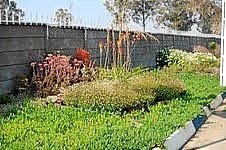
By Helen Devmac With the end of winter just before the onset of the rains comes spring, and “how does your garden look like ?” Everything in the garden should be blooming and bursting into life. This is the most beautiful time of the year if you are lucky enough to have a garden. All this beauty that surrounds us can be improved if you have a good knowledge of plants and how to strategically place them in your garden.
According to Ken, you can be guaranteed of a garden that is pleasant to look at throughout the year.
Ken is an experienced garden planner, and with his help, you too can have the best garden on your street, and remember that all gardens do not necessarily need a green backdrop.
It may be important that you get an opportunity to see a dry garden before making up your mind about the sort of garden you would want to grace your property with. For myself, since the day I spoke to Ken, I am beginning to see dry gardens everywhere — at the entrance to private properties, business premises, etc.
Just this weekend, I noticed that a property in the close in which I live has a dry garden, and luckily for all who live within the close, this property is at the entrance to the close and I really cannot remember when this was installed. But not so long ago, there were unsightly weeds and dry grass, where now lies this oasis.
The properties of a dry garden It uses locally available materials such as gravel, glitter-stone, Chinhoyi stone-in, rocks of different textures, colours and sizes and granite. These materials are earthy and provide colour and a natural backdrop to your garden — a backdrop that is truly Zimbabwean.
- Chamisa under fire over US$120K donation
- Mavhunga puts DeMbare into Chibuku quarterfinals
- Pension funds bet on Cabora Bassa oilfields
- Councils defy govt fire tender directive
Keep Reading
Plants are important to the dry garden just as they are to any other garden because they give life and structure to your garden.
Plants are chosen carefully. Texture, colour and shape are all important, but all plants must be hardy and be able to withstand high temperatures with minimum watering and shade.
This is where Ken’s vast knowledge of plants comes in. A lot of the plants he uses are locally available and indigenous. But he also makes use of exotic desert flora. In his plant nursery he has an impressive collection of plants, all at different stages of development from which to make a selection.
The way the dry garden is structured also guarantees a minimum of weeds, so that all in all, this is a very low maintenance garden, requiring little watering and virtually no weeding.
Although very little water is required, it is important that a regular watering routine is followed. It is therefore important to secure a guaranteed water supply.
Remember that last week we spoke about the installation of a water tank into which water may be fed from your normal household supply.
Ken is able to advise on the sort and size of tank you would need and exactly where to position this in your garden.
Should you decide that the dry garden is for you, Ken is a garden designer who is worth speaking to. His experience has taught him that the client’s input is of utmost importance. In fact, everything hinges on the client’s wishes.
So every consultation with Ken starts with finding out what the client really wants. He will help you conceptualise your garden on paper. This is usually followed by a site visit and thereafter, he will guide you in making the best choices for your garden.
This obviously includes making the correct plant selections and trees and placing these in a way that not only beautifies your garden, but gives your property a lasting appeal all year round.
Most important of all, this is an opportunity for you to learn and appreciate the beauty that lies in our indigenous plants and trees.
You need to also remember that it is possible for you to enjoy having a dry indigenous garden, while at the same time having patches of green exotic plants under shade, provided that your garden allows for this.











